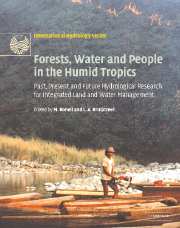 Forests, Water and People in the Humid Tropics
Forests, Water and People in the Humid Tropics Book contents
- Frontmatter
- Contents
- List of contributors
- Foreword
- Preface
- Acknowledgements
- Symposium and Workshop
- Introduction
- Part I Current trends and perspectives on people–land use–water issues
- 1 Trends and patterns of tropical land use change
- 2 The myth of efficiency through market economics: a biophysical analysis of tropical economies, especially with respect to energy, forests and water
- 3 Impacts of land cover change in the Brazilian Amazon: a resource manager's perspective
- 4 Forest people and changing tropical forestland use in tropical Asia
- 5 People in tropical forests: problem or solution?
- 6 Useful myths and intractable truths: the politics of the link between forests and water in Central America
- 7 Land use, hydrological function and economic valuation
- 8 Water resources management policy responses to land cover change in South East Asian river basins
- 9 Community-based hydrological and water quality assessments in Mindanao, Philippines
- Part II Hydrological processes in undisturbed forests
- Part III Forest disturbance, conversion and recovery
- Part IV New methods for evaluating effects of land-use change
- Part V Critical appraisals of best management practices
- Conclusion: Forests, water and people in the humid tropics: an emerging view
- Plate section
- References
1 - Trends and patterns of tropical land use change
from Part I - Current trends and perspectives on people–land use–water issues
Published online by Cambridge University Press: 12 January 2010
- Frontmatter
- Contents
- List of contributors
- Foreword
- Preface
- Acknowledgements
- Symposium and Workshop
- Introduction
- Part I Current trends and perspectives on people–land use–water issues
- 1 Trends and patterns of tropical land use change
- 2 The myth of efficiency through market economics: a biophysical analysis of tropical economies, especially with respect to energy, forests and water
- 3 Impacts of land cover change in the Brazilian Amazon: a resource manager's perspective
- 4 Forest people and changing tropical forestland use in tropical Asia
- 5 People in tropical forests: problem or solution?
- 6 Useful myths and intractable truths: the politics of the link between forests and water in Central America
- 7 Land use, hydrological function and economic valuation
- 8 Water resources management policy responses to land cover change in South East Asian river basins
- 9 Community-based hydrological and water quality assessments in Mindanao, Philippines
- Part II Hydrological processes in undisturbed forests
- Part III Forest disturbance, conversion and recovery
- Part IV New methods for evaluating effects of land-use change
- Part V Critical appraisals of best management practices
- Conclusion: Forests, water and people in the humid tropics: an emerging view
- Plate section
- References
Summary
INTRODUCTION
Tropical regions have undergone dramatic land use changes in the last few decades. The myriad of changes that have, and still are, taking place are the effect of an equally large number of local causes and factors, highlighting a complexity that tends to defy easy generalisations. Major background driving forces can be recognised, however, such as rapid demographic expansion, with consequent booming demands for agricultural land and woodfuels, plus a change from a subsistence-based to a market-orientated economy, with the associated heavy pressure on natural resources to fuel economic growth and development or, in some regions, political instability and incurable conflicts.
From this complexity of tropical land use dynamics, one single resulting element has been recognized with considerable alarm over the past decades. This is the progressive depletion of natural tropical forests. It is in fact to assess the remaining area of forest and its rate of change, rather than to study the complexity of tropical land use dynamics per se, that large-scale studies have been carried out over tropical regions. From a hydrological point of view, the removal of forest cover causes important changes in runoff and sediment yields (cf. Grip et al., this volume). Moreover, global concern over the fate of tropical forest has been coupled, especially during the last decade, with similar global concerns over the build-up of greenhouse gases in the atmosphere and the negative role that tropical deforestation plays in this regard (cf. Costa, this volume).
- Type
- Chapter
- Information
- Forests, Water and People in the Humid TropicsPast, Present and Future Hydrological Research for Integrated Land and Water Management, pp. 9 - 39Publisher: Cambridge University PressPrint publication year: 2005
References
- 7
- Cited by


